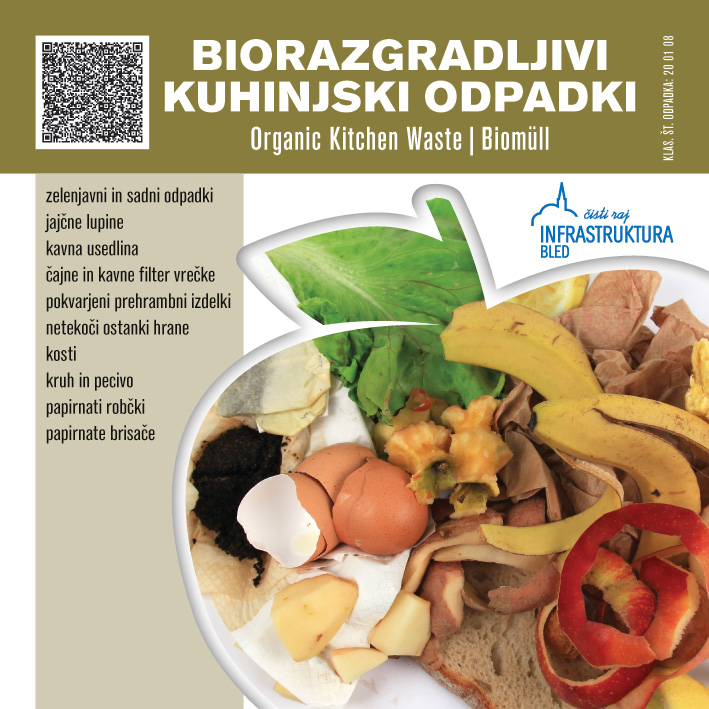Biodegradable kitchen waste
Biodegradable waste represents more than 30 percent of all domestic waste. It is prohibited to mix kitchen waste with other waste types, or to cut, crush or grind the waste in order to deposit it via wastewater into a cesspool or sewers.
Waste Framework Directive 2008/98/EC introduces an order of 5-levels of waste management. It first incorporates prevention of the generation of waste, and the preparing of waste for re-use, and concludes with recycling, recovery (compost) and disposal. You can read more about composting at home here: Composting.

Items that can be put in the container for biodegradable kitchen waste:
- vegetable and fruit waste of different types (fruit, vegetable, vegetable and fruit remains and peelings),
- eggshells and coffee sediments,
- tea and coffee filter bags,
- tainted food,
- non-liquid cooked food waste, bones,
- stale bread and biscuits,
- tissues, paper towels and paper sacks.
Items that CANNOT BE PUT in the container for biodegradable kitchen waste:
- green garden waste (grass, leaves, branches, flowers, hedges),
- oils and fats,
- liquid food waste,
- cigarette ends,
- napkins and sanitary towels,
- textiles, leather, cork,
- ashes,
- slaughter waste, dead animals
- pet excrement,
- hazardous waste,
- packaging waste,
mixed waste.
Legislation in the area of waste management requires reduced quantities of biodegradable waste at waste dumps. The separate collection of waste requires reduced quantities of disposed waste at waste dumps,and reduced volumes of greenhouse gases (methane is generated during the decomposition of biodegradable waste on landfills, which threatens the ozone layer 21-times more than CO2), and biodegradable waste can finally be processed into a compost or biogas of high quality.
In the EU one third of food is wasted. In 2011, Slovenia wasted 82 kilograms of food per capita, which is why the Surplus food project is so important, and the change of food labelling from “best before” to “date of minimum durability” is to be emphasized.
People often mistakenly believe that they must waste any food with an expired date of durability, even if it expired yesterday and even if the food may be still edible. It is important to note that the date on the package means the recommended date of durability, until which the food may be sold.
(Source: vizita.si/clanek/zdravozivljenje/uporabno-najmanj-do.html.)
We can reduce the quantity of waste food by only buying the quantity of food that we can use until the expiry date, as well as by storing the food appropriately. If we cannot avoid the build-up of surplus food within the date of minimum durability, we could give the food to humanitarian organizations, whereupon their volunteers may distribute the food to people who need help. The Ministry of Agriculture and the Environment has been running a project of collecting surplus food from supermarket chains, as well as partially from schools and kindergartens. Household food waste can often be used as animal feed (example: stale bread). After that we can consider using the food as compost and finally disposing of it at a collecting point.

Biodegradable waste (biological kitchen waste + green garden waste) represents more than 30 percent of all domestic waste.During decomposition of biodegradable waste methane gas is produced which damages the ozone layer 21-times more than CO2.
